Build the true experience
Chapter 4
Your guide to the true experience in a home theater installation.
Your guide to the true experience in a home theater installation.
Loudspeaker design is really my domain of expertise, as it has been the core of my professional life for years.
I have designed speakers for the Hi-Fi market, recording studios and predominately professional sound reinforcement applications.
I will start by defining loudspeaker categories, by technology and by shape (a more determining factor than one may think at first glance).
Loudspeaker categories
There is one criterion that is the most critical to intelligibility, dynamic performance and overall quality: The mid- and high-frequency range. There are four main technologies, so I will describe the four categories.
Why is it the mid and highs that will define the categories?
Just because, not only is it the most critical range for sound quality, the most sensitive range to the ear, but also the one which is the most challenging to speaker designers.
In comparison, the low frequency range is ‘easy’ if you put together well known design criteria.
In the residential domain, these are in vast majority. In recording studios, they can be found in near-field monitors, but seldom in main monitoring systems. In Public Address, they just do not exist at all.
The main reason is the low available Sound Pressure Level (SPL) with this kind of tweeter. Some of the best performing dome tweeters can reach a sensitivity of 96 dB /1 w /1m (very few of them!) whilst handling a maximum power of 20 W. So, doing the maths, we can reach a maximum SPL at 4m (typical listening distance for a Home Cinema) of 97 dB in theory. This is without counting the thermal compression loss, which on such tweeters at full power can be 6 dB or even beyond. So, we only have 91 dB left!*
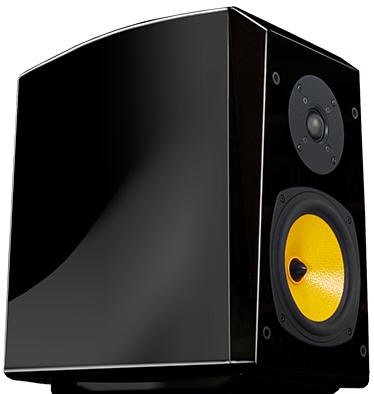
Fortunately the SPL requirement in the high frequency range is less than elsewhere, the maximum required energy being located in the 100-500 Hz or even 100-3000 Hz ranges (see curves below).

The above curves represent the energy distribution statistics of audio signals. The red curve corresponds to classical music programs, the blue one to rock music, and the green one to miscellaneous signals including music, speech and noises. When it comes to movie soundtracks, the relevant curve is obviously the green one. As can be seen, classical music is quite gentle to dome tweeters when compared to other programs.
As can be seen from the above graph, movie soundtracks require the full available SPL up to 3.5 kHz, a frequency that is reproduced by the tweeter in most designs.
However, such typical Hi-Fi loudspeakers are quite interesting with regards to some criteria:
But in view of their SPL limitations I think that most are not suitable for Home Theater applications: They are just not capable of correctly reproducing the large SPL variations that can be found on many movie soundtracks.
Still, there are some applications where dome tweeters can be used with satisfying results: Surround speakers and ceiling speakers - just because the required SPL is relatively low in comparison to that of the front speakers.
This type of drive unit delivers acoustic efficiency comprised between 20% and 25%, and directional gains of typically 15.5 dB (this is for a 90° x 40° coverage horn, which is a standard in the industry), the sensitivity reaches 117.5 dB /1W /1m (1 acoustical Watt provides an approximate SPL of 109 dB at 1m in 360° spherical radiation).
This looks better...
So, at 4m we still have 105 dB for 1 W and 115dB for 10 W (a power at which the compression driver is still running cool, so the thermal compression is negligible).

Another interesting aspect is the technical breakthrough that occurred in horn design by the late seventies: The directivity control.
Controlling HF and MF directivity has allowed an accurate determination of the audience coverage and in predicting how the loudspeaker would match the room geometry. We will look deeper into this in the next chapter about room acoustics.
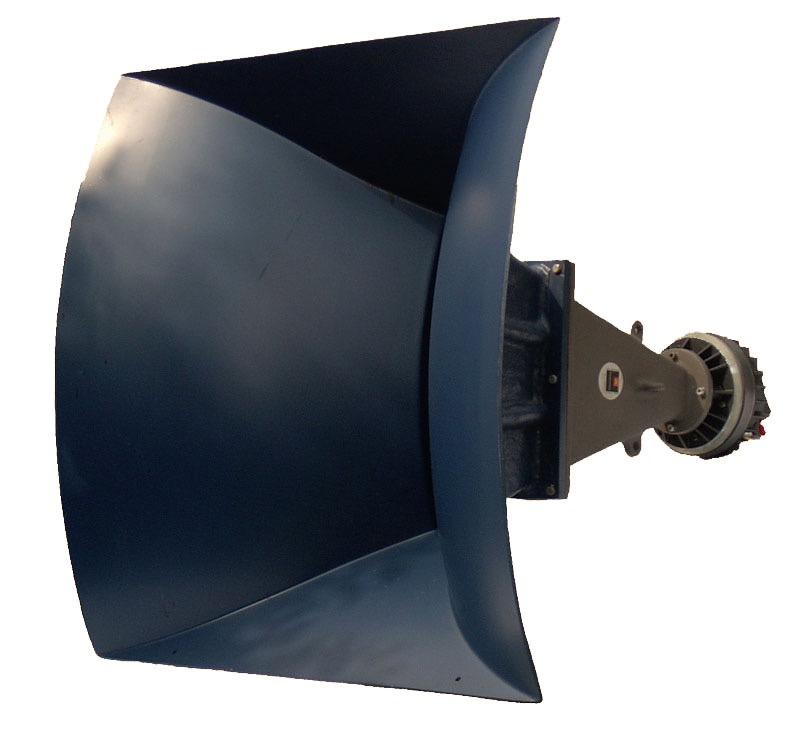
JBL 9360, a typical component in THX commercial cinema loudspeakers
From a subjective standpoint, compression drivers provide an unrivalled clarity, precision, intelligibility and a great feel of endless headroom.
Modern horn & compression driver assemblies do not have the flaws that are often believed to be inherent to the technology, i.e. distortion, roughness, coloration, etc.
These are biased comments due to old-time train station P.A. systems with a single low-cost compression driver loaded by a folded steel horn trying desperately to reproduce the whole audio spectrum (practically limited to 500 Hz-5000 Hz by the horn itself).
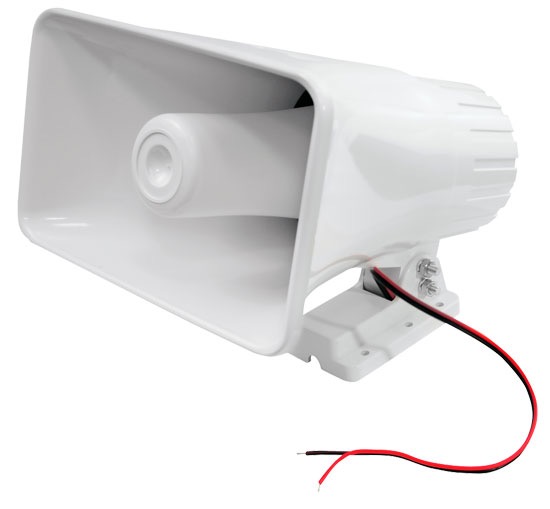
Some audiophiles blamed horn-loaded transducers, saying that they had a ‘projected sound’ a notion that I have difficulties in understanding. Maybe this is what the shape of the horn visually suggests, in the same way as floor-scratching spikes below loudspeakers stands suggest ‘mechanical diodes’ that would drain vibrations out to the ground (BTW, by ‘ground’, do they mean the floor?)
Some other audiophiles, however, are horn-loaded speaker addicts, so I’m happy to let them debate...
There is another sub-category of compression driver design: the coaxial (or ‘dual concentric’ speaker.
A compression driver is installed at the rear of an LF driver magnet, the exit of which goes through its axis. It is loaded partly by a gently expanding throat inside the LF driver magnet, it’s exit is followed by the LF diaphragm that in fact forms the last part of the horn.
There are a few advantages:
There is still a drawback:
Ribbons have very low inertia diaphragm, as the driving force is more or less uniform on the whole emitting surface. For this reason, they can provide the same level of clarity and intelligibility as compression drivers.
This is only a qualitative criterion, not a quantitative one. In practice, few ribbons are able to provide very high SPL levels, but still there are some.
A problem frequently encountered with ribbons is the presence of diaphragm resonances. These might go unnoticed upon first listening, or even sound pleasant: It often sounds a bit like added reverberation, but it fact it is a form of colouration.
This depends on the transducers themselves: Some have this flaw, others don’t.
The most common use of ribbon transducers is for HF reproduction, in combination with classic voice-coil loudspeakers for the lows and mids. In such an application, the larger the ribbon, the larger the available SPL is. But 8” to 12” long ribbons suffer from excessive directivity problem in the far field, and are not large enough to provide substantial near-field coverage.
An alternative consists of using small-sized horn-loaded ribbons in order to increase the sensitivity, hence the available SPL, and provide directivity control.
Finally, there are some quite interesting designs using very tall ribbons handling the majority of the audio spectrum. In that case, the far-field directivity is extremely high in the mid and high frequencies, but the near-field sound coverage is sufficiently extended as its height is the one of the ribbon (see drawing below). This way, the audience area can be totally covered by the near field sound.
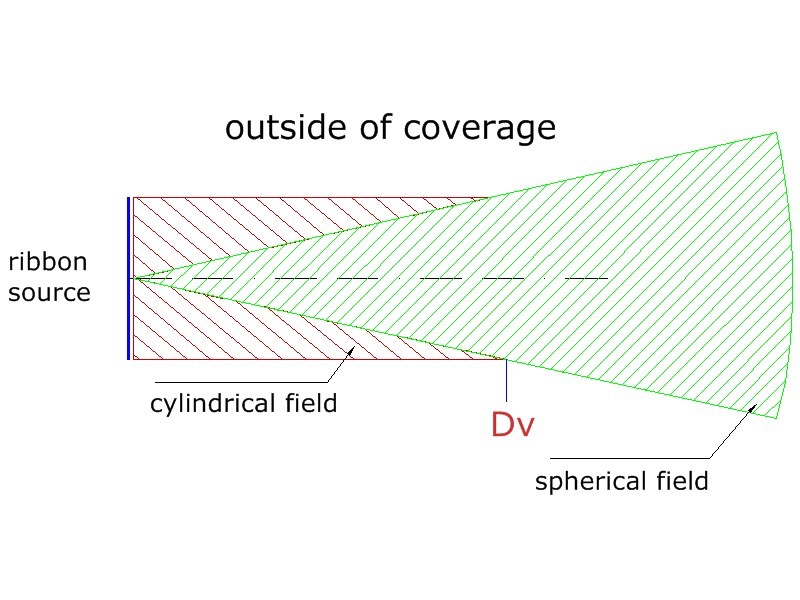
Lateral view of a ribbon transducer sound field. The height of the sound field is constant in the near-field zone, and its shape is a portion of a cylinder. The spherical portion of the sound field (in green) is actually a portion of a cylinder having a horizontal angle identical to the one of the cylindrical sound field.
Two things must be noted:
Side effect: The further you are from the source, the more this attenuation law increases the relative level of HF versus mid and low frequencies. In normal sized rooms, this effect is not of enough amplitude to seriously affect the tonal balance
In this type of large-bandwidth ribbon transducers, the best known brands are BG and Wisdom audio.
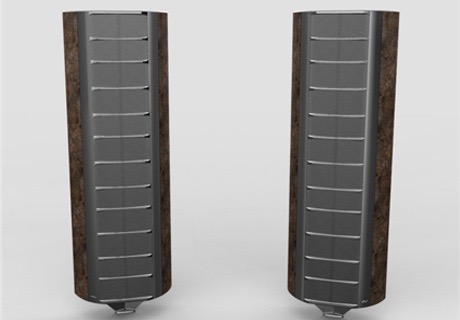
Wisdom audio ribbon loudspeakers
Wide-band loudspeakers used to be very popular a few decades ago, especially in their whizzer-cone configuration. This is the only configuration that is compatible with a dimension capable of providing a sufficient sensitivity.
Often their sensitivity is quite good (94 dB to 99 dB /1W/1m, typically for an 8” driver), but they only offer low power handling.
This type of transducer has been out of fashion since the late sixties, when they were replaced by low-efficiency 2-way designs.
For at least a generation, these designs were used only for low-cost industrial P.A., typically in-ceiling fed by a 70V or 100 V line.
It was only at the beginning of this century that some audiophiles re-discovered the liveliness and high dynamic capability of this type of driver.
A handful of manufacturers have focused on improving these designs, particularly the linearity of their frequency response, quite uneven in most cases.
Example of an 8’’dual-cone driver response mounted on a plane baffle.

Most audiophile loudspeaker designs based on this type of driver use very large rear folded horns to increase the low-frequency response, which is typically weaker than the mid-highs. The main problems with this approach are the size of the final loudspeaker, the cost of the cabinet and the low power handling (typically 30W to 50 W). This low power handling is due to the need for a very low moving mass, implying a small voice-coil.
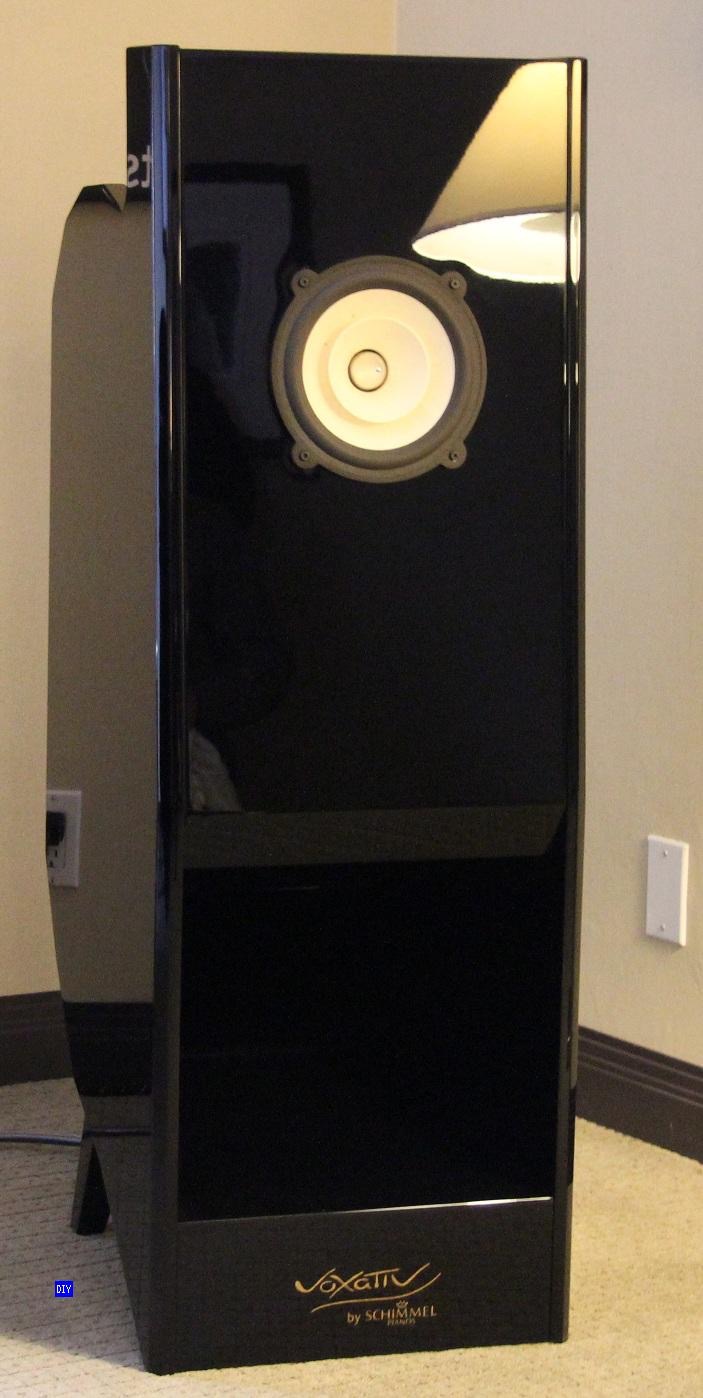
To be honest with you, although I would never endorse this approach due to the drawbacks I have mentioned, it has been one of my most enjoyable listening experiences. The loudspeaker was using an 8” Lowther driver loaded with an unfinished front horn loading of the ‘Theater Voice’ type in a huge ported cabinet.
I think a more realistic design could be a 2-way type, with a classic high-power bass driver for the bass up to somewhere between 250 and 500 Hz, crossed over with a dual cone high-efficiency wide band driver reproducing frequencies above the cut-off.
A digital crossover with DSP could also be used to smooth out the HF response of the whizzer cone.
This type of design would keep the dynamic capability and the clarity of the wideband driver, provide sufficient SPL, and would be of a decent size, unlike the loudspeaker in the above picture.
These speakers have proven excellent in reproducing a realistic vocal sound. The reference is still the very old Quad ESL 57, although its limitations make it totally unsuitable for Home Cinema:
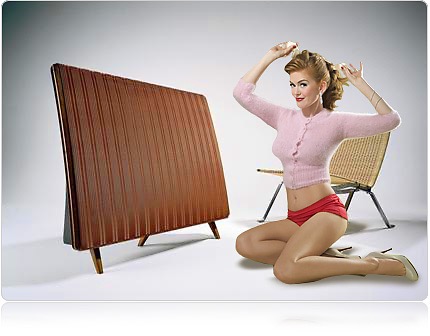
Advertisement for the Quad ESL 57. The model must be a grand ‘ma now!
More recent designs in electrostatic panels seem to have overcome these limitations, but I haven’t heard anything
There are mainly 4 types of loudspeaker shape:
These are mostly rectangular loudspeakers of a small size. They are supposed to be installed on a bookshelf. Typically used for near distance 2 channel Hi-Fi, they need to provide a decent low-frequency extension in spite of their small volume. This is at the expense of the sensitivity and of course of the available SPL. For this reason, such loudspeakers cannot be used for true Home Cinema installations, except maybe as surround speakers due to their small size - provided they do not have a rear-firing vent.
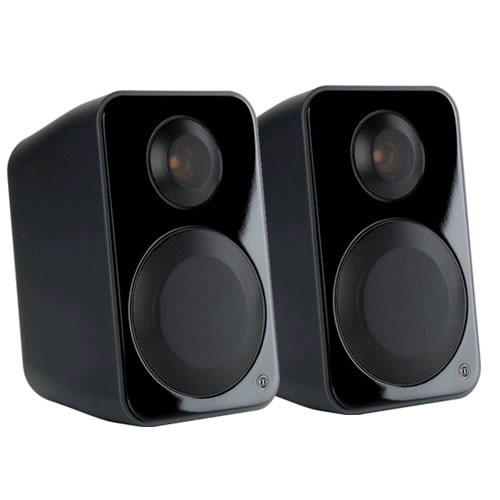
These are loudspeakers that have similar proportions to the ‘bookshelf’ type, but with larger dimensions. Actually, they are way too big to be placed on a bookshelf. They were the most popular ones when the WAF was not around. Today, they have a quite pertinent application in dedicated Home Theater rooms, hidden behind a screen.
They can be stand mounted, on a support structure, or even preferably integrated in a baffle wall to avoid rear wall reflections (see in the future Acoustics chapter).

Typically, they are of similar design to bookshelf speakers, but instead of being installed on a stand (actually, most bookshelf speakers cannot be installed on a bookshelf, as they have a rear-firing port!) they are significantly taller so the tweeter is at about ear-height when the speaker is just standing on the floor. Therefore, for the same footprint there is a significantly increased loading volume allowing a decent bass extension together with a nearly acceptable efficiency.
However, in most cases, the available dynamic range is still limited by a dome tweeter.

There are a few ‘floor standing’ loudspeakers that are designed for a good dynamic range. However, their shapes and sizes make them a bit difficult to install behind a screen...
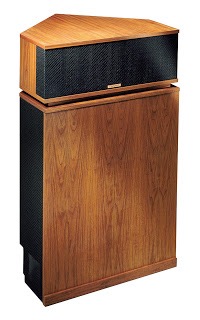

These are to be installed in a hole cut into a drywall partition. This type of speaker has long been considered a cheap, entry-level design only because they were meant to blend into the decor. For this mere reason, everyone assumed that the appearance and the ergonomics were the only design factor, and it was accepted that they would sound awful.
Bias!
These loudspeakers, of course, have to be quite shallow (3” to 4” max.), which implies:
The first criterion discards horns and compression drivers, but still allows the use of ribbon drivers or dual-cone wideband drivers.
The second criterion is not a problem in Home Cinema, as you can always use a separate subwoofer to reproduce the lowest frequencies (<100 Hz)
Finally, in-wall loudspeakers do provide some inherent advantages:
Rear wall reflection does not exist, as they are mounted flush in the wall
They ease the installation of the screen on the wall, as they do not protrude.
The WAF criterion is fully respected, allowing their use in multimedia rooms
Recently, well respected manufacturers have started producing quality and thoroughly designed in-wall speakers. However, not being able to use compression drivers, the SPL levels are generally limited below what we would expect.

There is very little to say about these : Their designs are similar to In-wall loudspeakers, except that rear wall reflection must be dealt with.

Thermal compression is a natural, inherent self-protection of the loudspeakers (against excessive power) and a plague for good sound reproduction.
What is it?
When the voice coil temperature rises, its resistance increases significantly. It can more than double in some instances.
Applying Ohm’s law, when a resistance increases, the power fed into the drive unit decreases, as the signal is a voltage. This translates into a reduced output.
Now, the more power you feed into a loudspeaker, the higher its voice-coil temperature is, this creates a compression effect.
It is a dynamic non-linearity due to a loss of sensitivity, which on a multi-way system might well end up into a tonal unbalance at high levels: There is no reason why an HF driver should have the same level of thermal compression as the LF driver at the same time.
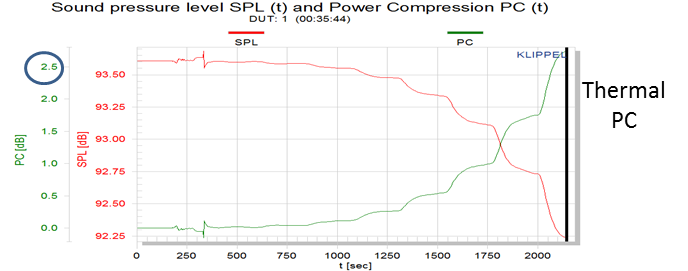
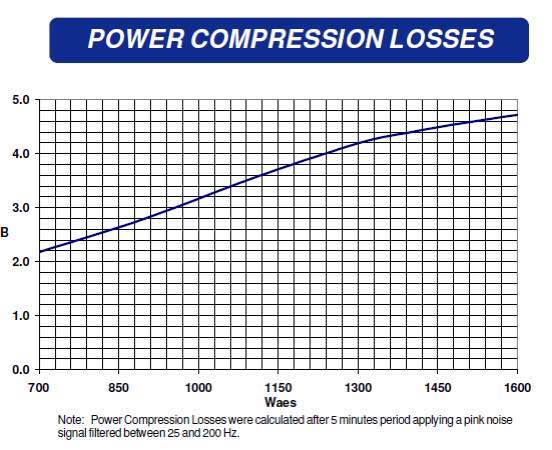
SPL and thermal compression curves (here called ‘power compression’)
Example of thermal compression as provided by a professional driver manufacturer (Beyma document) Please note the exceptional performance of this driver: the compression is only 2.2 dB at 700 W (this driver accepts 1.6kW)
But there is worse...
Temperature changes the impedance of the driver, as seen. If the loudspeaker comprises a passive crossover of an order higher than 1, the shape of the crossover function will be changed, as it is determined by the ratio of capacitances and inductances vs. the driver impedance. These changes, of course, will not be coherent in the low-pass section and in the high-pass section.
This is most likely to incur an erratic phase response at the crossover frequency, with a crossover alignment that varies with input level.
There is nothing you can do about it, except using an active crossover instead of a passive one.
The most common acoustic loads are the bass-reflex and the sealed box.
When you need bass extension, it is the best compromise to get it naturally at a reasonable volume. By ‘naturally’, I mean without electronic eq.
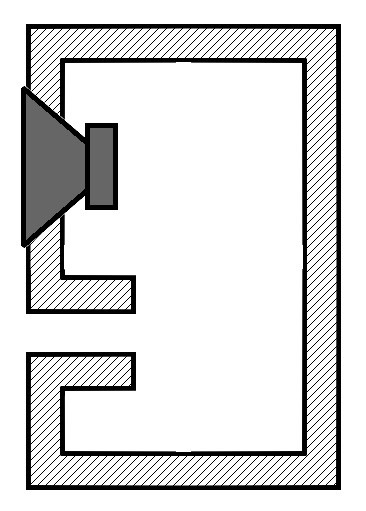
However, it has its inherent shortcomings:
This provides the best dynamic response and the shortest group delay. Its relatively simple impedance and phase responses make it reasonably easy to crossover in the 80 Hz-100 Hz region, provided its natural resonance frequency is not located in this area. However, if the loudspeaker is supposed to provide an extended bass response it will have to be bulky or use the assistance of electronic eq.
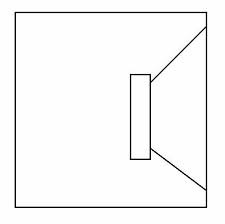
Ideal response for crossing over with a subwoofer around 80 -100 Hz
Very simple cabinetry hence reduced manufacturing cost.
Thermal problem: The rear of the bass drive unit is not in contact with ambient air. When driven hard, the temperature rises inside the cabinet, not allowing proper cooling of the voice coil, increasing thermal compression. Very few drive-unit manufacturers have addressed this issue by placing the driver motor in front of the cone. (Volt, Peerless. See the Volt driver in the PMC speaker on the picture above)
Quite uncommon, this type of load is sometimes used for subwoofers
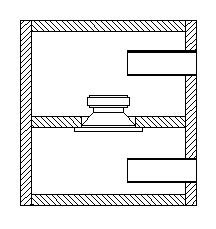
Its bandwidth is too limited for another application
Also unusual, although it generally provides quite a good bass response although It requires a bulky and expensive cabinet.

Quite pleasant to listen to when properly setup, it is very sensitive to room acoustics and to its placement with respect to the nearest walls. This is due to its 8-shaped directivity (dipole). For this reason, it is not really usable in Home Cinema installations.
Well, all this being said, I’ll leave the ‘politically correct’ region and give my raw opinion...
I’m not able to count the number of Hi-Fi loudspeaker manufacturers, but sometimes I feel they are more abundant than their customers. It looks like speaker design is an ‘open’ sport contest.
The design of the loudspeaker evolved in the late sixties from use in studio facilities to residential applications. From a specification which was to reproduce the sound as realistically as possible (wasn’t it a good idea?) it has changed to reproducing recorded music as pleasantly as possible. From then, loudspeakers started to become specialized. Strangely enough, the ‘High-Fidelity’ label was applied not to the loudspeakers that were meant to sound ‘realistic’, but to those which were designed to sound ‘pleasant’.
Worse, worser, worsest (it’s time for my English grammar lesson?) Now music is recorded and mixed so as to sound ‘not too bad’ on a mobile phone. Or at least one has to hear a little bit of it. This of course cancels the possibility to maintain a decent dynamic range in the musical content. When you play one of these tracks on a normal sound system, it sounds pretty boring (surprised?). Here comes the Hi-Fi smart designer: The loudspeakers are designed to add a little bit of pleasantness to these boring soundtracks. What’s wrong with it? By the way, this is often called ‘musicality’.
Is the movie soundtrack. With its full dynamic range and its devastating sound effects, it was never intended to be played back on a mobile phone. The recording studio has a sound system that is generally the same as a professional sound reinforcement system in a commercial cinema. The recorded track is sometimes directly copied on a blu-ray, sometimes remixed (we’ll never know unless we are there).
Is between the design criteria of Hi-Fi loudspeakers and the requirement of movie soundtrack playback, even in a residential environment. So, if you really need to playback both recorded music and movie soundtracks through the same system, you need to put together the dynamic capability of a concert P.A. system and the sweet distortion free, coloration free, natural sound of near-field monitors, but with a less ‘midrange forward’ tonal balance.
Is anything but easy. I cannot provide a magic five minute design course on loudspeakers that will solve it all. I can just list some things I would definitely avoid:
And there is one thing I would definitely want:
A digital crossover with DSP eq and delay functions.
Do not play your favourite CD on it. It is always pleasant to hear what you like, but this can fool you.
Instead, take a microphone (either a high grade one, or a “vocal” one like the Shure SM 58), a mic preamp or a small mixing desk, and feed this signal in mono to one loudspeaker (never two at the same time). Now, speak into the microphone and listen to your own voice.
You may argue that you don’t recognize your voice when it is recorded. Well, this is not surprising on your voice mail, but with a decent microphone and a good loudspeaker, it should sound right. Also, you should have a reference loudspeaker to make AB comparisons, and means to switch instantly from A to B.
It will take only a couple of seconds to identify which of the two speakers sound right and which one is definitely wrong. But the “right” one might not be quite right! It is only better than the other one…
Now, if you are in doubt how the voice should sound, try to get an old Quad ESL 57. This is hard to beat in terms of natural voice, although, as mentioned before it is not suited to Home Cinema.
Finally,
There is no need for garden-hose sized loudspeaker cables which provide an extremely low insertion loss and oddities if you have a passive crossover with an inductor having a parasitic resistance of 1 or 2 Ohms in series with the driver voice coil. The amplifier damping factor is jeopardized anyway.
Still, these expensive bulky and rigid cables do have a real consumer advantage: It is very difficult to hang yourself with them…
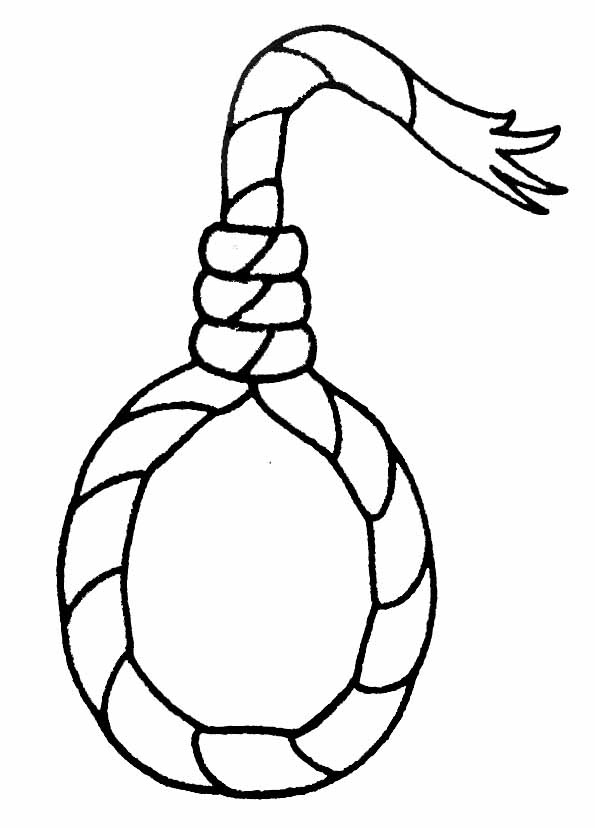
When calculating the acoustic pressure, the formula is: SPL= 20 Log P/P0, P0 being the reference pressure
When calculating the power, the formula is: WL= 10 Log W/W0
This just makes sense as W is proportional to P2
Let’s look deeper into the first calculation:
96 dB /1W/1m are 96+10Log 20 for 20Watts = 109 dB
at 4m, the attenuation is 12 dB, that is 97 dB (spherical waves are attenuated by 6 dB per doubling the distance).
Now, if we lose 6dB because of the thermal compression, we are left with 91 dB
Let’s look deeper into the second calculation:
1W in 360° spherical radiation provides 109 dB at 1m. If we reduce the radiating surface to a 90° sector in one axis and 40° in the other axis, the spherical area is reduced by a factor of 36. The power being the same, the Intensity Level is increased by a factor of 36.
As the intensity is proportional to power, the formula is:
IL= 10 Log I/I0
In our case, 10 Log 36 = 15.5 dB
The 20% efficiency gives an attenuation of:
10 Log 0.2 =-7dB
So the sum is 109 dB + 15.5 dB -7 dB, that is 117.5 dB. At 4m, we still have 105.5 dB for 1W power. At such a low power, the compression driver which is typically handling 50 Watts will not even be warm. There is no thermal compression.
Now if we raise the power to 50 Watts, the level will increase by 10 Log 50 = +17dB, but if we lose 6 dB because of thermal compression, the level will be 116.5 dB @ 4m, which is sufficient!
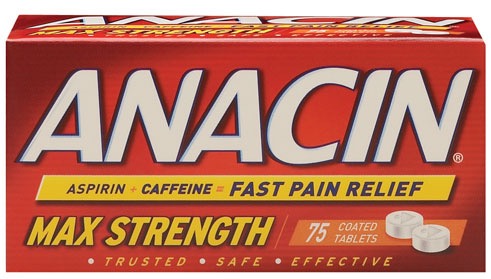
To be followed soon!